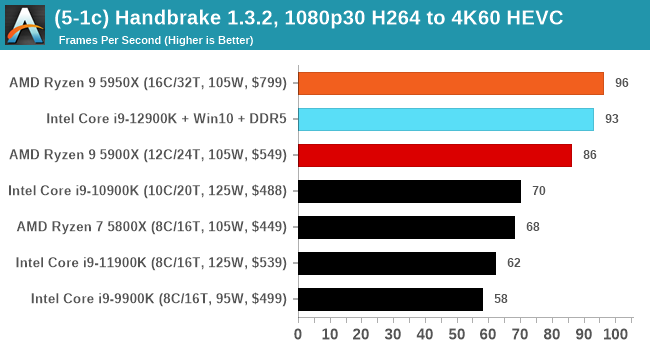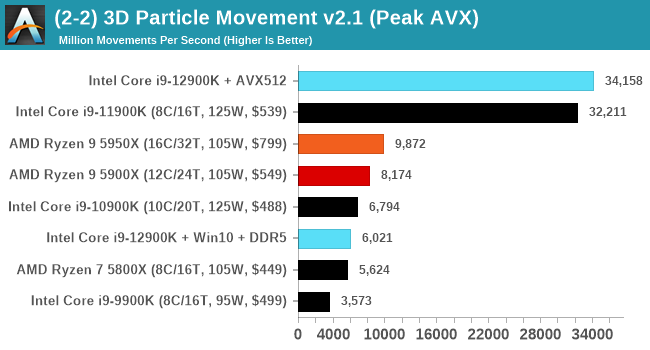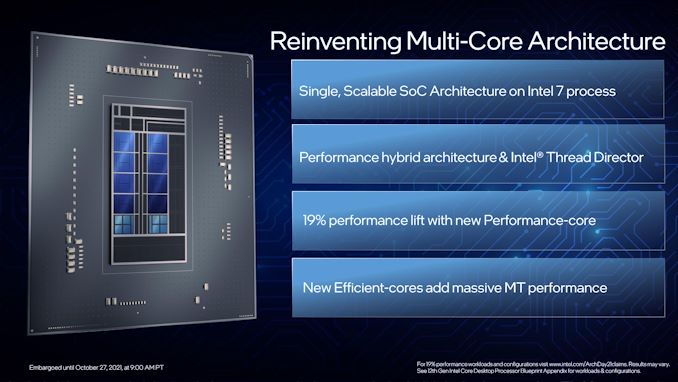The Intel 12th Gen Core i9-12900K Review: Hybrid Performance Brings Hybrid Complexity
by Dr. Ian Cutress & Andrei Frumusanu on November 4, 2021 9:00 AM ESTConclusion: Variables Maketh the CPU
Suffice to say, Intel’s new 12th Generation Core family has added more variables to the mix than a traditional processor launch. The combination of different types of core, coming at a time where a new operating system has just been launched, but also at the inflection point of a new type of memory. Let’s break down some of the differences we’ve observed in our testing.
When we compare Windows 10 to Windows 11, purely on throughput benchmarks, we don’t find much difference. There are a few spots where Windows 11 has a slight advantage in multi-threaded workloads, but this comes down to how new threads are spawned between the performance cores and the efficiency cores. Intel stated that the performance between the two, at least for CPU workloads, should be within a few percentage points, stating that Windows 11 should have lower run-to-run variance. We can corroborate this in our testing. Windows 10 also had some scheduling issues with low priority threads, which we expect to be ironed out with updates.
Comparing the new DDR5 to the old DDR4 is a different story, as the new memory standard offers a substantial uplift when it comes to memory bandwidth. As we saw recently with the M1 Max review, sometimes memory bandwidth can be a limiting factor. In our testing, DDR5 had a minor lead in single threaded tests but in a lot of multithreaded tests, the lead was significant. For real world, we had examples of +14% in Agisoft, +10% in NAMD, +8% in V-Ray, +10% in Handbrake, and +20% in WinRAR. In SPEC2017, we saw a couple of single threaded workloads get +15% improvements over DDR5, but in multi-threaded this was up to +40% on average, or more than 40% in specific tests. This also comes down to the doubled memory channels (4x32-bit vs 2x64-bit) which can be better utilized on top of the bandwidth increases.
Now comparing the P-core to the E-core, and it’s a story of how the E-core individually can perform on par with a Skylake core. Having eight extra Skylake-class cores is nothing to be sniffed at. In a lot of tests the E-core is half the performance of the P-core, but the P-core is itself is now the market leader in performance. The Golden Cove core inside Alder Lake has reclaimed the single-threaded performance crown with an uplift in SPEC of 18-20%, which is in line with Intel’s 19% claim. This puts it ahead of Apple’s M1 Max or 6% (int) and 16% (fp) ahead of AMD’s Zen 3 core.
The Core i9-12900K
Combining fast P-cores, Skylake-class E-cores, and DDR5 into one package means that Intel has certainly jumped from behind the competition to in front of it, or at least in the mix. When you have your operating system set up just right, and no issues with schedulers, it outperforms AMD’s offering when single core performance matters, and in multi-threaded workloads, it does tend to sit somewhere between a 5900X and a 5950X.

It’s important to note that in some tests, the Core i9-12900K does win outright. It’s at this point we should consider how much is core related vs standards related: DDR5 has produced somewhat of an uplift, and the competition is expected to claw some of that back when they introduce it, but those products are expected more towards the latter half of 2022. For users with those specific workloads today, and willing to pay the DDR5 early adopter tax, Alder Lake can provide performance uplifts right now.

Power is an interesting topic, and although our peak power numbers when all cores were loaded were above the 241W Turbo power on the box, in real world workloads it didn’t tend to go that high. The P-cores alone on the chip matched the power consumption of Intel’s 11th Generation in AVX2 workloads, but adding in the E-cores does put it over the previous generation. I’m not entirely sure what that says about Intel’s 7 manufacturing process compared to the 10SF used before. A lot of the performance gains here appear to come from IPC and DDR5, and that doesn’t seem to have come with performance per watt gains on the P-cores. It means that Intel is still losing on power efficiency at load compared to the competition.

I have to say a side word about AVX-512 support, because we found it. If you’re prepared to disable the E-cores, and use specific motherboards, it works. After Intel spent time saying it was fused off, we dug into the story and found it still works for those that need it. It’s going to be interesting to hear how this feature will be discussed by Intel in future.
Overall though, it’s no denying that Intel is now in the thick of it, or if I were to argue, the market leader. The nuances of the hybrid architecture are still nascent, so it will take time to discover where benefits will come, especially when we get to the laptop variants of Alder Lake. At a retail price of around $650, the Core i9-12900K ends up being competitive between the two Ryzen 9 processors, each with their good points. The only serious downside for Intel though is cost of switching to DDR5, and users learning Windows 11. That’s not necessarily on Intel, but it’s a few more hoops than we regularly jump through.











474 Comments
View All Comments
Netmsm - Monday, November 8, 2021 - link
@Wrs Assume we give you this, just drop AMD related things.Let's focus on performance per watt of new Intel Architecture. I asked some questions about this which is a pertinent topic to this article but you dodged. Just talk about 241 watt being sucked by 12900k :))
ajollylife - Sunday, November 7, 2021 - link
To be fair Intel's def not perfect. The i225v lan bug comes to mindDominionSeraph - Saturday, November 6, 2021 - link
When Intel doesn't have this issue it is AMD.Intel demands validation and spends hundreds of millions on engineers to help motherboard manufacturers fix their issues before release because they realize that the motherboard is an INSEPERABLE part of the equation. You can fanboi all you want over the CPU, but if there are no good motherboards you have a terrible system.
AMD just dumps their chip on the market, leaving the end-user with a minefield of motherboard issues among every manufacturer.
When Intel has the problem solved but AMD doesn't, it's an AMD issue.
Qasar - Saturday, November 6, 2021 - link
DominionSeraph have you tried this on a different x570 board ? it COULD be just that board, as was already stated. i have been running a 5900x now for about a week, and no issues at all with disk access, its the same as the 3900x i replaced, and im using an asus x570 e-gaming board.maybe take a step back, realize that its NOT an amd issue, but a BOARD issue. to be fair, intel has had its own issues over the years as well, while you see them as perfect, sorry to break it to you, but intel also isnt perfect
Netmsm - Sunday, November 7, 2021 - link
Oh I got it, the fact that you're encountering unusual issues, despite myriads of people who haven't complained of the same problem you have, means that AMD got many incompatibility issues.That's a brilliant reasoning which brings us to a pure conclusion: AMD is bad. We're done here.
Dug - Monday, November 15, 2021 - link
@DominionSeraph"Note Intel doesn't allow "dog sh1t motherboards" to happen, especially at the $300+ price point. That makes it an AMD issue."
You obviously haven't looked at or experienced the issues that plague many motherboards. Maybe just read some reviews or visit manufactures forums to get an idea of how bad it is before making such a naïve statement.
It has more to do with the manufacturer of the board than the CPU.
That is like saying nvidia doesn't make crap video cards. Well you need to look at all the failures by each manufacturer, not nvidia itself.
madseven7 - Saturday, November 6, 2021 - link
You put that chip in an ASROCK motherboard. That's the reason for the issues.xhris4747 - Tuesday, November 9, 2021 - link
Lol 😅FLORIDAMAN85 - Friday, November 12, 2021 - link
I, too, have made the error of purchasing an ASRock board.mode_13h - Saturday, November 13, 2021 - link
So far, my ASRock Rack server board is still going strong.